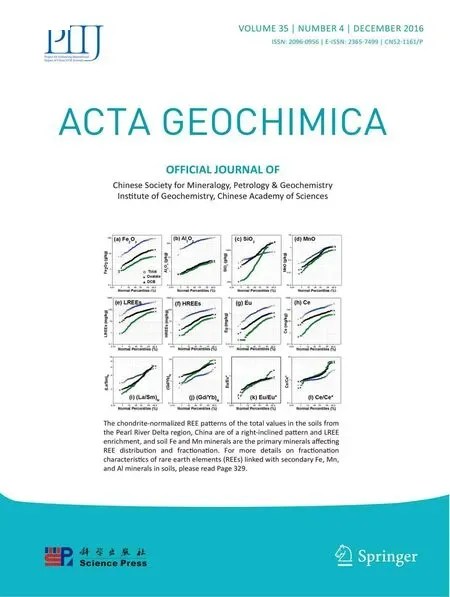Study on oil-source correlation by analyzing organic geochemistry characteristics:a case study of the Upper Triassic Yanchang Formation in the south of Ordos Basin,China
2016-11-21DeluLiRongxiLiBaopingWangZhiLiuXiaoliWuFutianLiuBangshengZhaoJinghuaChengWenbinKang
Delu Li·Rongxi Li·Baoping Wang·Zhi Liu·Xiaoli Wu·Futian Liu· Bangsheng Zhao·Jinghua Cheng·Wenbin Kang
Study on oil-source correlation by analyzing organic geochemistry characteristics:a case study of the Upper Triassic Yanchang Formation in the south of Ordos Basin,China
Delu Li1·Rongxi Li1·Baoping Wang2·Zhi Liu2·Xiaoli Wu1·Futian Liu1· Bangsheng Zhao1·Jinghua Cheng1·Wenbin Kang1
In the south of the Ordos Basin,the oil source of the Upper Triassic Yanchang Formation is confused all the time,which affects further exploration.In this study,oil sources from the oil layers of Ch6,Ch8 and Ch9 are all analyzed and confirmed.Through their carbon isotope value and biomarkers,characteristics of crude oils from the Yanchang Formation are analyzed.Then,the oil-source relation is discussed,with the source rocks’features. Finally,the oil-source relation is calculated through cluster analysis.It is believed that the oils from the Yanchang Formation deposit in a similar redox environment,with weak oxidation-weak reduction,and have all entered maturity stage.Ch9 crude oil is more mature than crude oils from Ch6 and Ch8,and has more advanced plants and fewer algae.Gas chromatography(GC)and gas chromatography-mass spectrometry(GC-MS)analysis show that crude oils from Ch6 and Ch8 may come from Ch7,and Ch9 crude oil may not.Cluster analysis displays that crude oils from Ch6 and Ch8 have closer squared Euclidean distance with Ch7 source rocks than Ch9 crude oil does,indicating crude oils from Ch6 and Ch8 stem from Ch7 source rocks.And Ch9 crude oil has rather close squared Euclidean distance with Ch9 source rocks,illustrating Ch9 crude oil may be from Ch9 source rocks.This research may provide the theoretical basis for the next exploration deploy in the south of Ordos Basin.
✉ Rongxi Li
Rongxi99@163.com
1School of Earth Sciences and Resources,Chang’an University,Xi’an 710054,China
2Yanchang Oilfield Co.,Ltd,Yan’an 716000,China
Carbon isotope·Biomarker·Oil-source correlation·Cluster analysis·Yanchang Formation·Ordos Basin
1 Introduction
Oil-source correlation(in petroliferous basins)refers to the relation between crude oils and source rocks to confirm where gathered crude oils are from and to further predict the location of source rocks and reservoirs(Li 2000;Peng and Lü2003;Cao et al.2012).So far,oil-source correlation is studied mainly by geochemistry,including inorganic geochemistry and organic geochemistry.In inorganic geochemistry methods,trace elements are always used(Deng 1993;Jing et al.2001).But,under the influence of their migration and secondary changes,there are still some limitations when applying them.Through organic geochemistry,oil-source correlation has been widely applied and favourable results have been achieved at present.Guo et al.(2006)discussed the oil source of the Yanan Formation in the southwest of the Ordos Basin and ensured that crude oils from Yanan Formation were from the Yanchang Formation.Bai et al.(2013b)studied the geochemical characteristics of crude oils and the oil-source correlation of the Yanchang Formation in the center of the Ordos Basin through biomarkers.However,previous studies(Meng et al.2011;Bai et al.2013b)often focus on qualitative analysis using carbon isotopes and biomarkers,leading to subjective judgments.Oil-source relation is hard to be identified accurately through spectrums of biomarkers in view of similar sedimentary environments.So it is necessary to combine some cluster analysis methods(Chang et al.2004;Zhao et al.2015)to deliver the verdict on the source of crude oils more accurately.
The Ordos Basin is a large inner continental sedimentary basin in western China,with a huge oil resource potential in its Upper Triassic Yanchang Formation,developing two sets of source rocks(Ch7 and Ch9)(Duan et al.2013).So far it can be confirmed that oil from the Ch7 oil layer is derived from Ch7 source rocks(Bai et al.2013a;Zhao et al.2014;Ren et al.2014;Zhang et al.2013;Zhao et al. 2012;Liang et al.2011),while in other oil layers,the relation between the oil and source rocks has been controversial.Some scholars(Luo et al.2010;Zhang et al. 2011)argued that oil from the whole Yanchang Formation is from Ch7 source rocks in the southwestern basin. However,other experts insisted that in the south central basin,oil from the Yanchang Formation stems from lower Ch9 source rocks,instead of Ch7 source rocks,and discussed the migration path before summarizing the different accumulation models with various reservoir cap assemblages(Duan et al.2009;Zhang et al.2008;Zhou et al. 2008).Given that they contain abundant fingerprint information,biomarkers can be applied to ascertain the oilsource correlation from 3 aspects:forming environment,kerogen type and maturation(Connan and Cassou 1980;Li et al.1999;Duan et al.2006).Consequently,by means of multiple parameters and spectrums of biomarkers,the oilsource relation can be discerned in previous research. Nonetheless,the similar geochemistry characteristics of Ch7 and Ch9 source rocks can still result in confused conclusion concerning oil source.Therefore,the issue of the oil-source relation needs to be further studied,which has significant meaning for further petroleum exploration of the Yanchang Formation.
In this paper,the crude oils geochemistry characteristics of the Yanchang Formation are analyzed primarily,including the crude oils carbon isotope value and their group compositions,n-alkanes and isoprenoids,steroid series and terpenoid series.Then,based on geochemistry characteristics and cluster analysis,the oil-resource correlation is conducted.After comprehensively judging the information,the sources of oil in different oil layers are finally proved.
2 Geological settings
Located in structural binding site of Midwestern China and consisting of six first-order tectonic units,Weibei Uplift,Yishan Slope,Yimeng Uplift,Jinxi Flexure Zone,Tianhuan Depression and Western Thrusted Zone(Fig.1a),the Ordos Basin is the end product of movements affected from the Pacific plate and Tethyan oceanic crust after Indosinian movement(Wang 2011),which is one of the main basins developing hydrocarbon in China.The Yanchang Formation from the Upper Triassic,especially,is the most significant oil layer in the Ordos Basin in view of its abundant oil and gas reserves.
The Upper Triassic Yanchang Formation is divided into ten oil layers from top to bottom(Ch1 to Ch10),of which Ch9 and Ch7 are the main source rocks.The Ch9 oil layer develops 2 sets of fine source rocks at the top and bottom interlayered with dark gray and dark purple mudstones,siltstone and post stone.The Ch7 oil layer,in particular,was deposited 80-100 m in the deep lacustrine environment with a subsidence center near Fuxian(Duan et al. 2013),composing of dark gray mudstones and carbonaceous mudstone with thin siltstones at the top and charcoal grey mud,argillaceous siltstone and oil shale in the low part(Fig.1b).Tilting to the northwest,the study area is situated in the transitional region between the Weibei Uplift and Yishan Slope,with an area of 1800 km2(Fig.1a).
After the late Triassic,the area undergoes the formation and development period of tectonic evolution into a large inland basin of diverse sedimentation,receiving deposit of Triassic in the whole area(Yang and Deng 2013).Indosinian movement in the late Triassic and later Yanshan movement cause its unbalanced uplift,with various degrees of weathering denudation and deformation,resulting in the stratigraphic gaps from Ch6 oil layer to overlying Jurassic stratums and Ch1 and Ch2 oil layers to be universally missing from the southwestern area(Fig.2).So far,industrial oil flows have been discovered in Ch6,Ch7,Ch8 and Ch9 oil layers.
3 Samples and analysis methods
In this study,10 samples were collected from source rocks of Ch7 oil layer and 10 samples were collected from crude oil of Ch6,Ch8 and Ch9 oil layers in the study area,which were dispersedly located(Fig.2).
The source rock samples were extracted with chloroform(CHCl3)for 72 h.after being powdered under 80 mesh.Chloroform bitumen‘A’analysis of source rocks were conducted by SY/T 5118-1995.
For group compositions analysis,50 mg fractions of rock extracts or oils were analyzed,of which asphaltene was deposited with hexane.After solvent removal by rotary evaporation,the rock extracts or oils were fractionated using column chromatography(silica gel/alumina,3:1)into saturates,aromatic and resins.The additive elution solvents were hexane,benzene and anhydrous alcohol.Analysis method was followed by SY/T 5119-2008.
For the carbon isotopic analysis of group compositions,chloroform bitumen‘A’and crude oil,experiments were performed on MAT252,with 68 eV electron energy,200 mass resolution,<2×10-6Pa vacuum degree and0.8 mA emission current.The carbon isotope standard is the PDB standard,with less than±0.3‰test error.

Fig.1 a The geological map of Ordos Basin and location of studied section and b stratigraphic column of Upper Triassic Yanchang Formation(modified after Qiu et al.2014)
The saturates of oils and extracts were tested by gas chromatography(GC)and gas chromatography-mass spectrometry(GC-MS)in Geochemistry Laboratory,China University of Petroleum.Gas chromatography(GC)analyses were conducted on an SHIMADZU GC-2010,under 26°C indoor temperature and50%relative humidity,equipped with a 30 m×0.25 mm×0.25 μm HP-5 fused silica capillary column,with He as the carrier gas.Then the gas is boosted at the rate of 1.0 mL/min.The initial temperature of GC oven was kept at 100°C.After 1 min,the temperature was increased to 300°C at a rate of 4°C/min,and then held at 300°C for 25 min.The temperatures set for both the injector and FID were 300°C. The testing standard was followed by GB/T 18340.5-2010.
Gas chromatography-mass spectrometry(GC-MS)analyses were performed on an Agilent 6890GC/5975i MS,under 26°C indoor temperature and50%relative humidity,equipped with a 60 m×0.25 mm×0.25 μm HP-5MS fused silica capillary column,with He as the carrier gas.Then the gas is boosted at the rate of 1.0 mL/ min.The initial temperature of GC oven was kept at 50°C. After 1 min,the temperature was increased to 120°C at arate of 20°C/min,and then held at 310°C for 25 min.The testing standard was followed by GB/T 18606-2001.

Fig.2 Distribution of Yanchang Formation sedimentary strata before Jurassic in study area
4 Results and discussions
4.1Geochemical characteristics of crude oil samples
Group compositions of crude oils are commonly affected by their source rocks sedimentary backgrounds,kerogen types,evolution degree,later modification and so on(Sofer 1984;Peters et al.1996;Zhang and Xu 1992;Chen and Xu 1992;Shen 2002;Wang et al.2005;Zhang 2006).On the condition of similar organic matter,high mature crude oils should have more hydrocarbon components and less polar components,compared with low mature crude oil(Chang 2004).
In terms of their carbon isotope value(from-32.9‰to-31.7‰)and their group compositions(Table 1),crude oil samples from the Yanchang Formation have similar distribution characteristics(Fig.3),such as depositing in similar environment,for example,fresh water or brackish water,possibly,and being dominated by type I kerogen.

Fig.3 Carbon isotopic distribution of crude oil samples and their group compositions in Yanchang Formation X20-Ch6 represents sample of Ch6 oil layer from X20 well and the rest are the same expression as this one
The gas chromatogram of saturated hydrocarbon of crude oil samples from the Yanchang Formation also show similar distribution features,with n C15-n C20as the main peaks and approximate pristine and phytane(Fig.4). Normally,the evolution degree becomes high as the oddeven predominance(OEP)approaches 1(Luo et al.2015). The OEP of crude oil samples are in a narrow range from 1.04 to 1.12,with an average of 1.08,implying similar weak oxidation-weak reduction sedimentary conditions and mature characteristics.In addition,their kerogen types are mixed types dominated by algae,which is consistent with the conclusion of crude oil carbon isotope and group compositions analysis.
The distribution and content of phytane(Ph)and pristane(Pr)are related with the redox conditions(Li et al. 1999;Hanson et al.2000;Peters et al.1999).Under a strong reducing environment,phytol,the parent materials of phytane and pristane,would mainly transform into phytane;under a weak oxidizing environment,phytol would mainly transform into pristane(Meng et al.2011). Therefore,the Pr/Ph ratio is a direct indicator used for judging the ancient redox environment.The Pr/Ph ratio of the Yanchang Formation crude oil samples are from 0.62 to 0.87,with an average of 0.76(Table 2),revealing that there is a tiny discrepancy between them and a similar type of biological sources.According to the water oxidationreduction degree index proved by Haven(1987),the crude oil forming condition of Yanchang Formation is a weak oxidation-weak reduction environment.As can be seen from Fig.5,the data of the crude oil samples projected to a relatively small region,illustrating that they may have similar parent materials.

Table 1 Carbon isotopic value of crude oil samples and their group compositions in Yanchang Formation

Fig.4 Gas chromatogram of saturated hydrocarbon of crude oil samples in Yanchang Formation,O-X56-Ch9 represents crude oil sample of Ch9 oil layer from X56 well and the rest are the same expression as this one
During the evolution of the steroid series,the regular steroids 14,17(H)are converted from a αα configuration to a ββ configuration,with the chiral carbon atoms converted from a R-biological configuration to a S-geological configuration(Huang et al.1990;Mei 1980).So it is appropriate to research maturity by comparing the different configuration of the steroid series.αααC2920S/(20S+20R)and C29ββ/(ββ+αα)increase with the raising of the degree of maturity,with a reaction equilibrium value of 0.52-0.55 and 0.67-0.71,respectively(Seifert and Moldowan 1986).The αααC2920S/(20S+20R)and C29ββ/(ββ+αα)of the crude oil samples from the Yanchang Formation are in a range of 0.49-0.54 and 0.38-0.56,respectively,illustrating that the oils have been mature(Fig.6)(Chen et al.1998;Zhao 2007;Huang et al. 1990).
C27and C28regular steranes are mainly from lower aquatic organisms(e.g.various algae)and C29regular sterane can be typically not only from algae,but also from advanced plants.Regular steranes in the mass chromatogram are normally distributed in the shapes of‘V’,‘L’and reversed‘L’.The first two shapes show that lower aquatic organisms are involved during sedimentation,while reversed‘L’means containing advanced plants(Bai et al.2013b).
The mass chromatogram of steranes of Ch6 and Ch8 crude oil samples all distribute in a reversed‘L’shape,which means their parent materials have advanced plants. And mass chromatogram of steranes of Ch9 crude oil sample distribute in a‘V’shape,which means algae are dominated in its parent materials more than advanced plants,compared with Ch6 and Ch8 crude oil samples(Fig.7).The Ch9 crude oil sample has the characteristics of Ts>Tm.However,Ch6 and Ch8 crude oil samples show Ts<Tm,which illustrates that the Ch9 crude oil sample is more mature than those of the Ch6 and Ch8(Fig.7).
The distribution of regular steranes of crude oil can provide its parent materials(Duan et al.2006).The C29regular steranes of the crude oil samples of the Yanchang Formation have a higher mean percentage of 42.36%,compared with C27and C28regular steranes with relatively lower average percentages of 29.3%and28.34%,respectively.A ternary diagram of C27,C28and C29regular steranes compositions display that the parent materials of the crude oil samples of the Yanchang Formation are from mixed types,mainly lower aquatic organisms and terrestrial advanced plants(Fig.8).

Table 2 Biomarker parameters of source rocks and crude oils in Yanchang Formation,Ordos Basin

Fig.5 Cross plots of Pr/n C17versus Pr/Ph rations in the studied crude oil samples and source rock samples in Yanchang Formation,R-X40-Ch7 represents source rock sample of Ch7 oil layer from X40 well and the rest are the same expression as this one
In the terpenoid series,hopanoids are transformed from a biological configuration of ββ-C30hopanes to a geological configuration of αβ-C30hopanes and from 22R to 22S in the evolution process(Mei 1980).Thus,βα-C30moretane/αβ-C30hopanes and C31homohopane22S/(22S+22R)can be indicators for judging the maturity of crude oil.βα-C30moretane/αβ-C30hopanes and C31homohopane 22S/(22S+22R)are from 0.09 to 0.12 and from 0.47 to 0.56,with an average of 0.10 and 0.53,respectively(Table 2),which means a similar forming environment and mature characteristics to the crude oil samples of the Yanchang Formation.
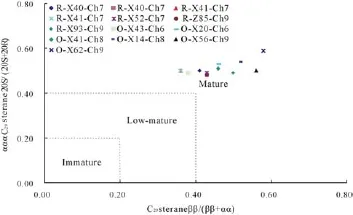
Fig.6 Cross plot of αααC29sterane20S/(20S+20R)versus C29steraneββ/(αα+ββ)rations in studied crude oil samples and source rock samples in Yanchang Formation
4.2Oil-source correlation
4.2.1Geochemical characteristics of source rock samples The carbon isotope value is always used to discern the tiny fluctuated variation of the δ13C in organic matters.The carbon isotope value of crude oil,its group compositions and chloroform bitumen‘A’can be formed to diverse tendency lines,ascertaining an oil-source relation between crude oils and source rocks(Li et al.2000).
The carbon isotope value of chloroform bitumen‘A’’and the group compositions of source rock samples in Ch7 have approximative distributions,implying their similar sedimentary environment and parent materials,and the carbon isotope value of chloroform bitumen‘A’is from-32.0‰ to-27.9‰ with an average of-29.7‰(equivalent to Ro=0.7%-0.8%).

Fig.7 Mass chromatogram of hopanes(m/z 191)and steranes(m/z 217)of crude oil samples in Yanchang Formation
To be specific,two source rock samples from the X40 well possess higher carbon isotope values of chloroform bitumen‘A’than other samples,which may be caused by the different properties of their parent materials.This can also explain the anisotropism of the source rock samples.
Comparing Fig.3 with 9,crude oil samples from the Yanchang Formation almost have the same tendency lines with Ch7 source rock samples(Table 3),reflecting that there may be close relationship among them.
During the degradation of it,kerogen would be full of heavier δ13C.The values of δ13C normally decrease with the reducing polarity of each group composition,showing characteristics of asphaltenes>resins>aromatics>saturates(Zhang 2006).However,thermal maturation and migration have an effect on the carbon isotope of each group composition,so it is reasonable to consider other biomarkers in association with the oil-source correlation.
Saturated hydrocarbon mass chromatograms of Ch7 source rock samples uniformly show a single peak type with C15and C19as the main peak and no obvious odd-even predominance(Fig.10),reflecting that their configurations are close to each other with plenty of algae input. But there are still differences among the source rock samples’sedimentary environments.Ch7 source rock samples from the X40 well have a higher oxidation degree than other samples with Pr/Ph=1.70(Fig.5).One of the source rock samples from the X41 well is closely related to Ch6 crude oil from the X20 well and the X43 well,Ch8 crude oil from the X14 well and the X41 well and Ch9 crude oil from the X59 well,indicating they may have the same consanguinity,while source rock samples from the X40 well are far from crude oil samples,reflecting rather far relation among them(Fig.5).
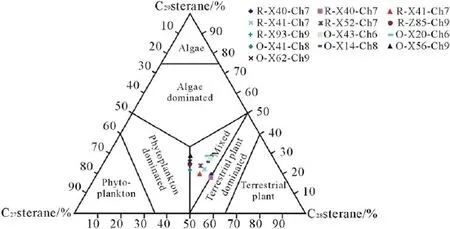
Fig.8 Ternary diagram of C27,C28and C29sterane compositions in crude oil samples and source rock samples in Yanchang Formation,and the base map is from Zhao et al.(2015)
Regular steranes of Ch7 source rock samples have the similar reversed‘L’shape distribution with crude oil samples from Ch6 and Ch8,suggesting crude oil may come from Ch7 source rocks(Fig.11).However,Ch9 crude oil samples with a‘V’distribution may not stem from Ch7 source rocks.

Fig.9 Carbon isotope distribution of chloroform bitumen‘A’and group components of Ch7 source rock samples
At the same time,C31hopanes22S/(22S+22R)versus Diasteranes/regular steranes shows that crude oil samples of Ch6 and Ch8 and Ch7 source rock samples are distributed in a small region with a short distance of Ch9 crude oil sample,which possibly implies crude oils from Ch6 and Ch8,instead of Ch9 crude oil,may stem from Ch7 source rocks(Fig.12).
The C31homohopane22S/(22S+22R)of about 0.60 attains equilibrium at the beginning of the oil window(Waples and Machihara1991).C31homohopane22S/(22S+22R)of Ch7 source rock samples are in range of 0.56-0.58 with an average of 0.57,implying that they have almost approached the oil window.
However,because of axis scales,Fig.12 can only declare a possible relation between the crude oil samples and source rock samples.Distances among samples would diminish when the axis scales enlarged,so it can only distinguish the possibility.
4.2.2Oil-source correlation cluster analysis
In conventional figures concerning oil-source correlations,oil-source relations are always influenced by axis scales.If the axis scales turn large,data casted into the figure are proved to have better relevance with minor distance.On the contrary,worse relevance among samples can be determined with small axis scales.Therefore,more analysis should be conducted to explore the relations of crude oil and source rocks.
For subtler research of oil-source correlations,more sensitive parameters and more accurate calculation methods should be used for analysis.Using relative Euclidean distance and the dendrogram of cluster analysis theory,correlations and attributes among samples can be clearly perceived.The basic logic of cluster analysis is to classify the similarity level of statistic value one by one,according to the affinity relationship diagram(Zhu et al.2000).

Table 3 Carbon isotopic value of Ch7 source rock samples and their group compositions

Fig.10 Staturated hydrocarbon mass chromatogram of Ch7 source rock samples
By using the hierarchical clustering method,the crude oil samples of Ch6,Ch8 and Ch9 and source rock samples of Ch7 and Ch9(Zhao et al.2015)are calculated by 17 parameters(Table 4).Correlations among crude oil samples of Ch6 from the X20 well and the X43 well and Ch8 from the X14 well and the X41 well are preferable(Fig.13),which illustrate that they come from the same source rocks.All the source rock samples from Ch7 have good correlations(Fig.13),demonstrating that the paleoenvironment of the sedimentary period has little difference in the study area,with higher correlations.

Fig.11 Mass chromatogram of hopanes(m/z 191)and steranes(m/z 217)of Ch7 source rock samples
Compared with those of Ch9 from the Z85 well and X93,source rock samples of Ch7 have good correlations with the crude oil samples of Ch6 and Ch8,which explains the fact that oil of Ch6 and Ch8 originate from Ch7 source rocks.Ch9 source rock sample from the Z85 well have 0.003-squared Euclidean distance(Table 4)with crude Ch9 oil sample from the X62,which means Ch9 oil is likely from Ch9 source rocks.And,Ch9 crude oil of the X56 well has worse relation with Ch7 source rocks,which shows that Ch9 crude oil doesn’t come from Ch7 source rocks in the study area.
5 Conclusions
Crude oils and their group compositions from the Yanchang Formation have similar carbon isotopic values(-32.9‰to-31.7‰),indicating they have similar parent materials(mainly algae)and forming environments. The biomarker parameters[OEP,Pr/Ph,regular steranes,αααC29sterane20S/(20S+20R),C29steraneββ/(ββ+αα),C31hopance22S/(22S+22R)etc.]of the crude oils from the Yanchang Formation reflect that the oils have already entered the maturity stage and were deposited in a weak oxidation-weak reduction sedimentary environment.

Fig.12 Cross plot of C31homohopane 22S/(22S+22R)versus Diasteranes/regular steranes rations in studied crude oil samples and source rock samples in Yanchang Formation
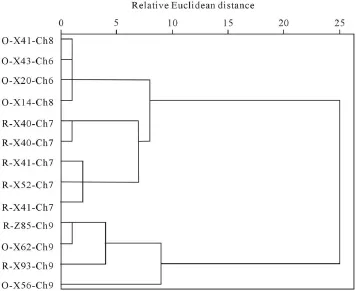
Fig.13 Cluster analysis of biomarker parameters in the studied crude oil samples and source rock samples in study area
According to the ratios and distribution characteristics of the biomarkers,the crude oils of Ch6 and Ch8 in study area,rather than Ch9 crude oil,are from Ch7 source rocks,. Ch9 crude oil may not come from Ch7 source rocks.By cluster analysis,crude oils of Ch6 and Ch8 have rather closer squared Euclidean distance with Ch7 source rocks,which means they do actually come from Ch7 source rocks. Ch9 crude oil has a further squared Euclidean distance with Ch7 source rocks,with a closer squared Euclidean distance with Ch9 source rocks,implying that Ch9 oil may stem from Ch9 source rocks.
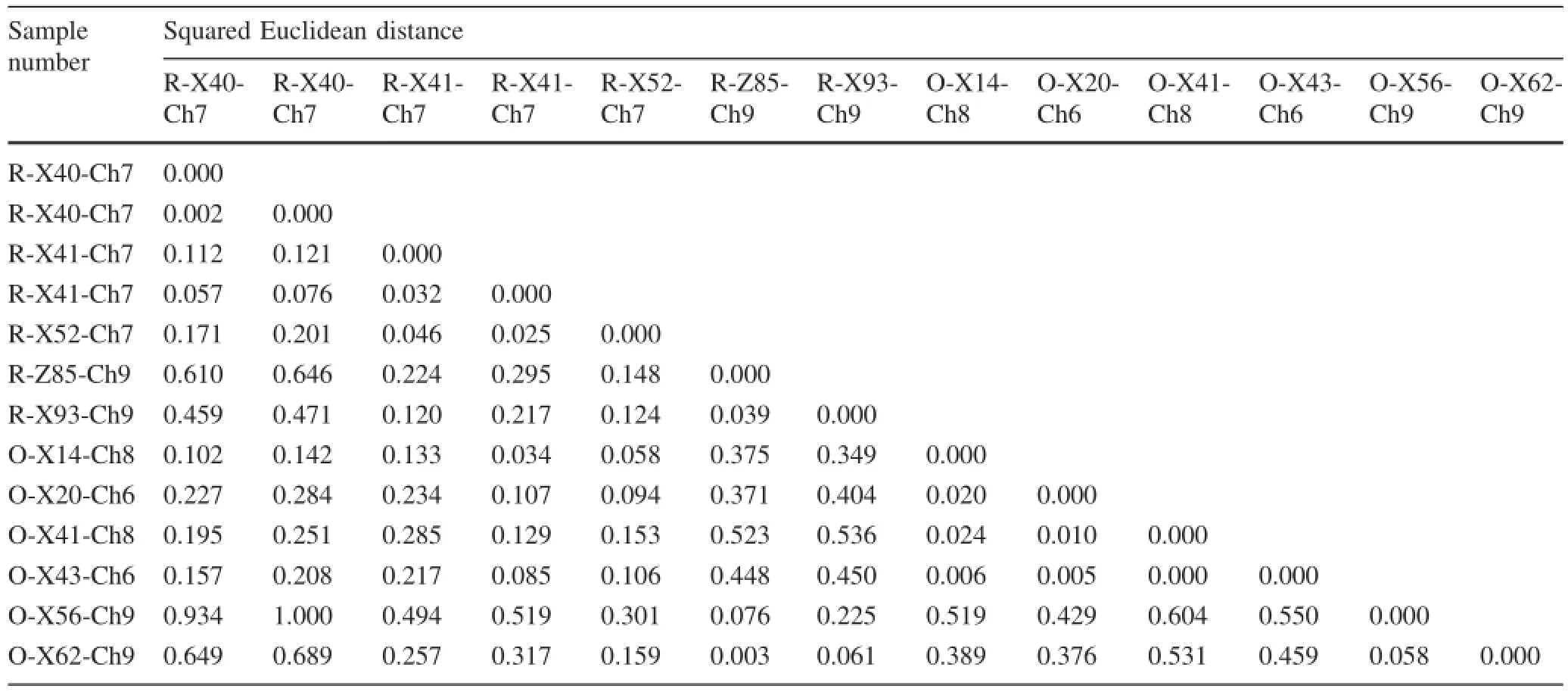
Table 4 Squared Euclidean distance between the studied samples in Yanchang Formation,Ordos Basin
Acknowledgments This work was supported with funding from the National Natural Science Foundation of China(No.41173055). Thanks are due to Dr.Jiajia Li of Chang’an University and Xingchao Jiang of Yangtze University for the constructive comments,which improved this paper greatly.
References
Bai YB,Zhao JZ,Zhao ZL,Yin YY,Tong JN(2013a)Accumulation conditions and characteristics of the Chang 7 tight oil reservoir of the Yanchang Formation in Zhidan area,Ordos Basin.Oil Gas Geol 34:631-639(in Chinese with English Abstract)
Bai YB,Gao ZD,Li ZF,Zhang ZS,Zhu J,Zheng H(2013b)Geochemical characteristics of crude oil and oil-source correlation in Yanchang Formation in Xingzichuan Oilfield,Ordos Basin.Pet Geol Exp 35:552-558(in Chinese with English Abstract)
Cao J,Wu M,Wang XL,Hu WX,Xiang BL,Sun PA,Shi CH,Bao HJ(2012)Advances in research of using trace elements of crude oil in oil-source correlation.Adv Earth Sci 27:925-936(in Chinese with English Abstract)
Chang J(2004)A study on geochemical characteristics and sources of oil produced from Wengu 2 well in Wenliu buried hill in Dongpu depression.Oil Gas Geol 25(44-48):69(in Chinese with English Abstract)
Chang XC,Wang MZ,Han ZZ(2004)Discussion on methods of oilsource correlations suitable for composite basins.J Earth Sci Environ 26:32-36(in Chinese with English Abstract)
Chen J,Xu Y (1992)Characteristic of organic carbon isotope composition in coal-bearing strata.Acta Sedimentol Sin 10:44-48(in Chinese with English Abstract)
Chen JY,Liu CY,Zhang SL,Bi YP,Bi YQ(1998)Composition of the biomarkers in crude oil is the reflection of pool-forming history.Earth Sci J China Univ Geosci 23:97-102(in Chinese with English Abstract)
Connan J,Cassou AM (1980)Properties of gases and petroleum liquids derived from terrestrial kerogen at various maturation levels.Geochim Cosmochim Acta 44:1-23
Deng P(1993)The application of trace amount of elements in the exploration of oil and gas.Pet Explor Dev 20:27-32(in Chinese with English Abstract)
Duan Y,Wu BX,Zhang H,Zheng CY,Wang CY(2006)Geochemistry and genesis of crude oils of the Xifeng Oilfield in the Ordos Basin.Acta Geol Sin 80:301-310(in Chinese with English Abstract)
Duan Y,Yu WX,Liu XY,Guo ZQ,Wu BX,Sun T,Wang CY(2009)Oil migration and accumulation rules of Chang 9 oil-bearing formation in the Ordos Basin.Acta Geol Sin 83:855-860(in Chinese with English Abstract)
Duan Y,Yuan Y,Qian R(2013)Migration features of crude oil in fluvial deposits of Maling oilfield in Ordos Basin,China.Org Geochem 58:78-85
Guo YQ,Li WH,Chen QH,Cao HX,Zhang DF(2006)Geochemical behaviors of oil and oil-source correlation in Yanchang Yan’an Formations in Ansai-Fuxian area,Ordos basin.Oil Gas Geol 27:218-224(in Chinese with English Abstract)
Hanson AD,Zhang SC,Moldowan JM,Liang DG,Zhang BM(2000)Molecular organic geochemistry of the Tarim Basin,Northwest China.AAPG Bull 84:1109-1128
Haven HLT,Leeuw JWD,Rullkötter J,Sinninghe DamstéJS(1987)Restricted utility of the pristane/phytane ratio as a palaeoenvironmental indicator.Nature 330:641-643
Huang D,Li J,Zhang D(1990)Maturation sequence of continental crude oils in hydrocarbon basins in China and its significance. Org Geochem 16:521-529
Jing Q,Tian HQ,Dai JS(2001)Application of microelement composition to the correlation of solid bitumen with source rocks.Exp Pet Geol 23:285-290(in Chinese with English Abstract)
Li MW (2000)Quantification of petroleum secondary migration distances:fundamentals and case histories.Pet Exp Dev 27:11-17(in Chinese with English Abstract)
Li M,Lin R,Liao Y,Snowdon LR,Wang P,Li P(1999)Organic geochemistry of oils and condensates in the Kekeya Field,Southwest Depression of the Tarim Basin,(China).Org Geochem 30:15-37
Li M,Ren P,Hu LG(2000)Application of carbon isotope typical curve to oil source correlation in Liaohe basin.Spec Oil Gas Reserv 7:11-27(in Chinese with English Abstract)
Liang XW,Wang HH,Niu XB,Wang CY,Feng SB(2011)Source rock evaluation and oil-source rock correlation in Triassic Yanchang Formation of the middle-western Ordos Basin,China. J Chengdu Univ Technol 38:402-407(in Chinese with English Abstract)
Luo X,Zhang L,Yang H,Fu JH,Yu J,Yang Y,Wu H(2010)Oil accumulation process in the low-permeability Chang-81member of Longdong area,the Ordos Basin.Oil Gas Geol 31:770-778(in Chinese with English Abstract)
Luo X,Zhao Z,Meng Y (2015)Application of an odd/even predominance of n-alkanes in oil-source rock correlation:taking the lower Paleozoic strata of the Tarim Basin as an example. Toxicol Environ Chem 97:409-416
Mei B(1980)The distribution of isoprenoid alkanes in China’s crude oil and its relation with the geologic environment.Oil Gas Geol 1:99-115(in Chinese with English Abstract)
Meng J,Liu L,Jiang Z,Wang Y,Gao Y,Liu S(2011)Geochemical characteristics of crude oil and oil-source correlation of the Paleogene‘Red Bed’in the south slope of the Dongying Depression,Bohai Bay Basin,China.Energy Explor Exploit 29:397-414
Peng PA,L XX(2003)Geochronology of reservoirs in Chinese superimposed Basins.China University of Petroleum Press,Beijing(in Chinese)
Peters KE,Cunningham AE,Walters CC,Jiang J,Fan Z(1996)Petroleum systems in the Jiangling-Dangyang area,Jianghan Basin,China.Org Geochem 24:1035-1060
Peters KE,Fraser TH,Amris W,Rustanto B,Hermanto E(1999)Geochemistry of crude oils from Eastern Indonesia.AAPG Bull 83:1927-1942
Qiu XW,Liu CY,Mao GZ,Deng Y,Wang FF,Wang JQ(2014)Late Triassic tuff intervals in the Ordos basin,Central China:their epositional,petrographic,geochemical characteristics and regional implications.J Asian Earth Sci 80:148-160
Ren ZL,Li WH,Liang Y,Wu XQ,Yu Q,Ren L,Wang W(2014)Tight oil reservoir formation conditions and main controlling factors of Yanchang Formation in southeastern Ordos Basin.Oil Gas Geol 35:190-198(in Chinese with English Abstract)
Seifert WK,Moldowan JM (1986)Use of biological markers in petroleum exploration.Methods Geochem Geophys 24:261-290
Shen P(2002)Isotopic Geochemical Characteristics of Low Mature Petroleum in Jinggu Basin.Acta Sedimentol Sin 20:151-155(in Chinese with English Abstract)
Sofer Z(1984)Stable carbon isotope composition of crude oils: application to source depositional environments and petroleum alteration.AAPG Bull 68:31-49
Wang SM (2011)Ordos Basin tectonic evolution and structural control of coal.Geol Bull China 30:544-552(in Chinese with English Abstract)
Wang CG,Wang TG,He FQ(2005)Stable carbon isotope and its significance in hydrocarbon accumulation in Tahe Oilfield,Tarim Basin.Xinjiang Pet Geol 26:155-157(in Chinese with English Abstract)
Waples DW,Machihara T(1991)Biomarkers for geologists:a pratical guide to the application of steranes and triterpanes in petroleum geology.In:AAPG methods in exploration series 9:91
Yang H,Deng XQ(2013)Deposition of Yanchang Formation deepwater sandstone under the control of tectonic events,Ordos Basin.Pet Explor Dev 40:549-557(in Chinese with English Abstract)
Zhang ZN(2006)Characteristics of carbon isotopic composition of soluble organic components of deep source rocks in Tarim Basin.Acta Sedimentol Sin 24:769-773(in Chinese with English Abstract)
Zhang A,Xu Y(1992)Preliminary study on the reversed distribution of stable carbon isotopes in sedimentary organic matter.Acta Sedimentol Sin 10:49-59(in Chinese with English Abstract)
Zhang WZ,Yang H,Peng LS(2008)Hydrocarbon accumulation significance of chang91high-quality lacustrine source rocks of Yanchang Formation,Ordos Basin.Pet Explor Dev 35:557-562(in Chinese with English Abstract)
Zhang XL,Duan Y,He JX,Wu BX,Xu L(2011)Geochemical characteristics of crude oil in lower part of Yanchang Formation and correlation of oil source in Huaqing area of Ordos Basin.Nat Gas Geosci 22:866-873(in Chinese with English Abstract)
Zhang NN,Liu LF,Su TX,Wu KJ,Zhao YY(2013)Comparison of Chang 7 member of Yanchang Formation in Ordos Basin with Bakken formation in Williston Basin and its significance. Geoscience 27:1120-1130(in Chinese with English Abstract)
Zhao DS(2007)Maturity of Tertiary Oil-source in West Qaidam Basin.Acta Sedimentol Sin 25:319-324(in Chinese with English Abstract)
Zhao JZ,Bai YC,Cao Q,Er C(2012)Quasi-continuous hydrocarbon accumulation:a new pattern for large tight sand oilfields in the Ordos Basin.Oil Gas Geol 33:811-827(in Chinese with English Abstract)
Zhao WW,Yang YX,Song HP,Li DL(2014)Geological characteristics and main controlling factors of hydrocarbon accumulation in Chang 7 tight oil of Yanchang Formation of Xiasiwan area,Ordos Basin.J Cent South Univ Sci Technol 45:4267-4276(in Chinese with English Abstract)
Zhao Y,Yao JL,Duan Y,Wu YZ,Cao XX,Xu L,Chen SS(2015)Oil-source analysis for Chang-9 subsection(upper Triassic)of Eastern Gansu province in Ordos Basin.Acta Sedimentol Sin 33:1023-1032(in Chinese with English Abstract)
Zhou JG,Yao GS,Deng HY,Xin YG,Hu H,Zheng XP,Gong QS(2008)Exploration potential of Chang 9 member,Yanchang Formation,Ordos Basin.Pet Exp Dev 35:289-293(in Chinese with English Abstract)
Zhu YH,Tai SC,Sun YY (2000)Application of mathematical statistics.Wuhan University of Hydraulic and Electric Engineering Press,Wuhan(in Chinese)
13 June 2016/Revised:19 July 2016/Accepted:18 August 2016/Published online:19 September 2016
©Science Press,Institute of Geochemistry,CAS and Springer-Verlag Berlin Heidelberg 2016
杂志排行
Acta Geochimica的其它文章
- Element geochemical characteristics of a soil profile developed on dolostone in central Guizhou,southern China:implications for parent materials
- Dissipation of polycyclic aromatic hydrocarbons in crop soils amended with oily sludge
- Geochemistry of sedimentary rocks from Permian-Triassic boundary sections of Tethys Himalaya:implications for paleo-weathering,provenance,and tectonic setting
- Standard-sample bracketing calibration method combined with Mg as an internal standard for silicon isotopic compositions using multi-collector inductively coupled plasma mass spectrometry
- The genetic relationship between Habo alkaline intrusion and its surrounding deposits,Yunnan Province,China:geological and S-Pb isotopic evidences
- Copper partitioning between granitic silicate melt and coexisting aqueous fluid at 850°C and 100 MPa
